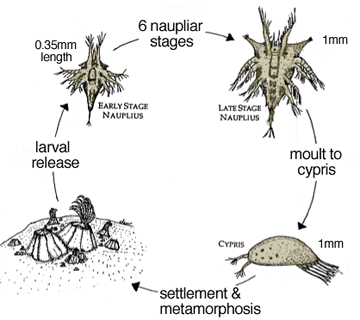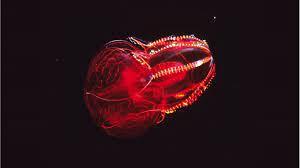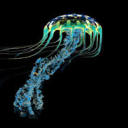If You Are Interested In Learning About Different Types Of Plankton In The Ocean, Please Check Out @planktonqueen
If you are interested in learning about different types of plankton in the ocean, please check out @planktonqueen page. I post a lot of cool species, photos, and facts.


Barnacle Larvae
Amphibalanus eburneus
When we think of barnacles, we think of the hard, white crustaceans that grow on the side of boats and docks. However, barnacles go through a variety life stages and metamorphosis before they spend their life on a hard surface. The image above is a barnacle larvae when it is in the cypris stage, think of it as a baby barnacle. This larvae is an example of zooplankton and spends a short period of time floating around in the water column. The second image summarizes the life cycle of a barnacle.
Photo source: https://www.nyharbornature.com/blog/barnacles-are-reproducing
https://www.pinterest.com/pin/453174781229895797/
More Posts from Bioluminescentoceangoddess and Others

Squarenose Helmetfish
Scopelogadus beanii
The Squarenose Helmetfish is found between 800m to 4000m in the ocean. It received this unique name due to its scales reminding scientists of an armored helmet worn by medieval knights. It also has unusual holes around its face, and the white strands covering its face are sensory canals.
Photo credit: https://www.vistaalmar.es/especies-marinas/peces-extranos/449-que-peces-mas-extranos.html
Dear ocean enthusiast and supporters,
Hi everyone, thank you for supporting my blog. I have gained over 500 followers and that is worth celebrating. I will try my best to post every day some of the amazing creatures that live in the deep ocean. Have a great night!


Jewel Squid
Histioteuthis heteropsis
The Jewel Squid is covered in color-changing photophores that resemble sparkling gem stones. They also have a light-red coloration and are about 20 cm in length. They display a unique behavioral adaptation called diel migration. During the day, they stay at depths around 400-1200 m, and then surface during night (0-400m). This behavioral pattern is designed maximize feeding at night, and avoid predators during the day. The primary predator of the Jewel Squid is the Sperm Whale.
Photo credit: https://www.pinterest.com/pin/722827808920240115/
https://twitter.com/theoctonation/status/1168516522270253056


Cockatoo Squid
Galiteuthis phyllura
The Cockatoo squid is a highly-specialized oddity of the deep ocean and found at depths between 300 to 1400 m. It is completely transparent, except for its eyes. It also has bioluminescent photophores that are directed downward: this makes it difficult for deep sea predators to see the Cockatoo Squid. It was named after the Cockatoo because it holds its tentacles above its head, resembling the bird. The Cockatoo squid can also get fairly large with adults reaching lengths of 2.7 meters (over 6 ft.)
Photocredit: https://www.americanscientist.org/article/at-home-in-the-dark
https://www.pinterest.com/pin/28710516347382519/



Fangtooth
Anoplogaster cornuta
The Fangtooth is a ferocious predator that is found at depths between 600 m to 5000 m. It has large, needle like teeth that are used to catch prey. It also has extremely sensitive sensory canals underneath of its scales used to detect movement in the water. Furthermore, their preferred prey are crustaceans and fish.
Photo credit: https://pixels.com/featured/fangtooth-fish-dant-fenolio.html
https://www.pinterest.com/pin/845902742487789950/
https://www.newscientist.com/article/mg23231020-400-up-close-with-the-giant-teeth-of-the-deepsea-fangtooth/


Blacksnout Seasnail
Paralipparis copei copei
The Blacksnout Seasnail may not look like a snail, but it does have a slimy, gelatinous substance that covers its body. It can be found at depths between 200 m to 1692 m, and adults grow up to be 17 cm in size (approximately 6.5 in). It also has an elongated body that resembles an eel. Furthermore, it can be seen rolling itself in a loop; this behavior is a defensive posture that makes it appear like a jelly. In the darkness, predators tend to avoid the Blacksnout Seasnail because its often mistaken as a hunter due to its appearance and behavior.


Deep Sea Arrow Worm
Eukrohnia hamata
Arrow worms are small, predatory marine worms that consume copepods, ostracods, and larvae. They resembles a clear, ink pen whizzing through the dark sea. Furthermore, they are found primarily in the Artic Ocean between 700m to 1200m. The picture on the bottom is its head. They have 8 hooks, which are used to grab prey and 25 posterior teeth. Even though the arrow worms are terrifying up close, they are only 4.5 cm in size.
Photo credit: http://www.arcodiv.org/watercolumn/chaetognaths/Eukrohnia_hamata.html
An amazing glowing ctenophore!


Bloody-belly comb jelly
Lampocteis cruentiventer
The Bloody-belly is a 16 cm ctenophore that is found at depths 700 m to 1200m. It is crimson red in color and appears black in the deep ocean. However, the jelly has the ability to emit a different color. Furthermore, it uses highly iridescent ctenes to propel through the water.
Photo credit: https://laughingsquid.com/bloody-belly-comb-jelly/
https://www.reddit.com/r/deepseacreatures/comments/2j1717/bloodbelly_comb_jelly_lampocteis_cruentiventer/


Giant Bell Jelly
Scrippsia pacifica
The Giant Belly Jelly has 256 tentacles attached to a gelatinous bell-shaped base. Like most cnidarians, the Giant Belly Jelly uses specialized stinging cells called nematocysts to catch its prey. When fish and other prey swim into its tentacles, the sensory projection on the cnidocyte (cell that holds the nematocysts) is activated. Then the nematocysts and barb are released, hitting the vulnerable prey and releasing a toxin into the prey’s body. The Giant Bell Jelly is found at 400 m in the ocean. It is related to the jellyfish, but it is categorized as a Hydrozoa (similar to the Portuguese- man-o-war)
https://vimeo.com/42551565
Photo Credit: https://www.pinterest.cl/pin/467107792572034837/
https://courses.lumenlearning.com/ivytech-bio1-1/chapter/phylum-cnidaria/


Pigbutt worm
Chaetopterus pugaporcinus
The Pigbutt worm or the flying buttocks of the sea is spotted floating between 965 m to 1300 m in the deep ocean. It is actually a polychaete (polly-keet) worm species that burrows in the ground as an adult, and floats around the ocean as a baby. The worm feeds itself : by creating a balloon of mucus; collecting particles on the mucus; and then consuming the particles. It is the rarest and thickest worm in the deep ocean, for only ten have been spotted.
Photocredit: https://roaring.earth/pigbutt-worm/
-
 briefcreatorcreator liked this · 1 year ago
briefcreatorcreator liked this · 1 year ago -
 maxinji liked this · 2 years ago
maxinji liked this · 2 years ago -
 808beat liked this · 3 years ago
808beat liked this · 3 years ago -
 kobithedragon liked this · 3 years ago
kobithedragon liked this · 3 years ago -
 teethandblood liked this · 3 years ago
teethandblood liked this · 3 years ago -
 docegrotesco liked this · 3 years ago
docegrotesco liked this · 3 years ago -
 zaisa liked this · 3 years ago
zaisa liked this · 3 years ago -
 clowngirlhaha reblogged this · 3 years ago
clowngirlhaha reblogged this · 3 years ago -
 sle3pydust reblogged this · 3 years ago
sle3pydust reblogged this · 3 years ago -
 donnerpartyofone liked this · 3 years ago
donnerpartyofone liked this · 3 years ago -
 heavensblade liked this · 3 years ago
heavensblade liked this · 3 years ago -
 morguemouth reblogged this · 3 years ago
morguemouth reblogged this · 3 years ago -
 feelslikepurgatory liked this · 3 years ago
feelslikepurgatory liked this · 3 years ago -
 3r4d liked this · 3 years ago
3r4d liked this · 3 years ago -
 illconsidered liked this · 3 years ago
illconsidered liked this · 3 years ago -
 milkandhoneyhearted liked this · 3 years ago
milkandhoneyhearted liked this · 3 years ago -
 triptihosmrti reblogged this · 3 years ago
triptihosmrti reblogged this · 3 years ago -
 l97ll reblogged this · 3 years ago
l97ll reblogged this · 3 years ago -
 l97ll liked this · 3 years ago
l97ll liked this · 3 years ago -
 binxthecat18 liked this · 3 years ago
binxthecat18 liked this · 3 years ago -
 rewindandunwind reblogged this · 3 years ago
rewindandunwind reblogged this · 3 years ago -
 oniongarlic reblogged this · 3 years ago
oniongarlic reblogged this · 3 years ago -
 creaturedeityendless liked this · 3 years ago
creaturedeityendless liked this · 3 years ago -
 sweet-sea-monster reblogged this · 3 years ago
sweet-sea-monster reblogged this · 3 years ago -
 recovery-witch liked this · 3 years ago
recovery-witch liked this · 3 years ago -
 nossalaguna liked this · 3 years ago
nossalaguna liked this · 3 years ago -
 wonderz-zx reblogged this · 3 years ago
wonderz-zx reblogged this · 3 years ago -
 random-animals reblogged this · 3 years ago
random-animals reblogged this · 3 years ago -
 steffi4chan liked this · 3 years ago
steffi4chan liked this · 3 years ago -
 diminishedtobe liked this · 3 years ago
diminishedtobe liked this · 3 years ago -
 texas-toadhouse reblogged this · 3 years ago
texas-toadhouse reblogged this · 3 years ago -
 ghost-in-a-wasteland liked this · 3 years ago
ghost-in-a-wasteland liked this · 3 years ago -
 spicesfrommars reblogged this · 3 years ago
spicesfrommars reblogged this · 3 years ago -
 spicesfrommars liked this · 3 years ago
spicesfrommars liked this · 3 years ago -
 dimens1ons liked this · 3 years ago
dimens1ons liked this · 3 years ago -
 that-lesbian-phenotype liked this · 4 years ago
that-lesbian-phenotype liked this · 4 years ago -
 violetbeetle reblogged this · 4 years ago
violetbeetle reblogged this · 4 years ago -
 flowerhatjelllys reblogged this · 4 years ago
flowerhatjelllys reblogged this · 4 years ago -
 vorpalrabbit liked this · 4 years ago
vorpalrabbit liked this · 4 years ago -
 dailykingdom-blog1 liked this · 4 years ago
dailykingdom-blog1 liked this · 4 years ago -
 poopypoopater liked this · 4 years ago
poopypoopater liked this · 4 years ago -
 alastaircrowley reblogged this · 4 years ago
alastaircrowley reblogged this · 4 years ago -
 alastaircrowley liked this · 4 years ago
alastaircrowley liked this · 4 years ago -
 amanita-fly-agaric-muscaria reblogged this · 4 years ago
amanita-fly-agaric-muscaria reblogged this · 4 years ago -
 amanita-fly-agaric-muscaria liked this · 4 years ago
amanita-fly-agaric-muscaria liked this · 4 years ago -
 xxxdragonfucker69xxx liked this · 4 years ago
xxxdragonfucker69xxx liked this · 4 years ago -
 puppetshell reblogged this · 4 years ago
puppetshell reblogged this · 4 years ago -
 puppetshell liked this · 4 years ago
puppetshell liked this · 4 years ago

Bioluminescence is a chemical reaction that produces light. Many deep sea animals use bioluminescence. This blog is dedicated to educating the public about the amazing creatures that thrive in the deep sea.
57 posts